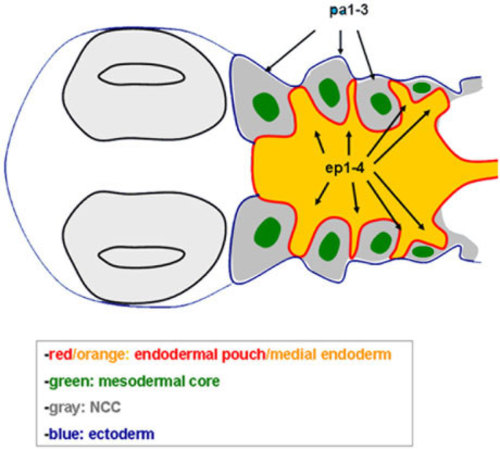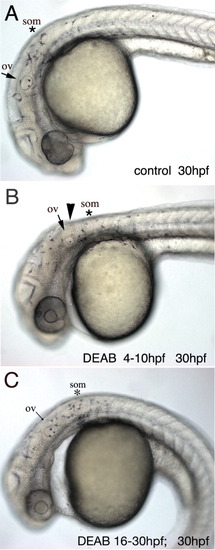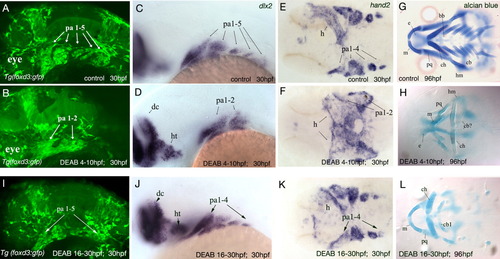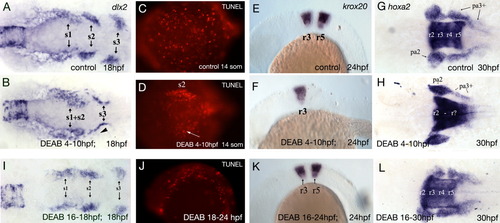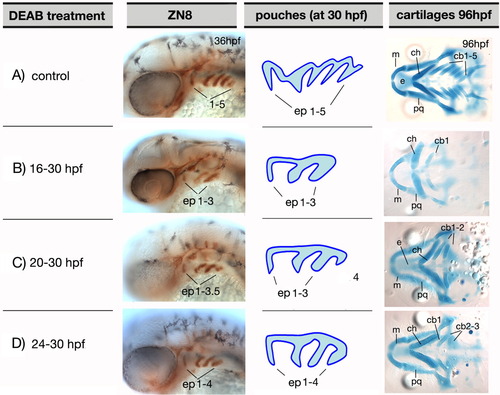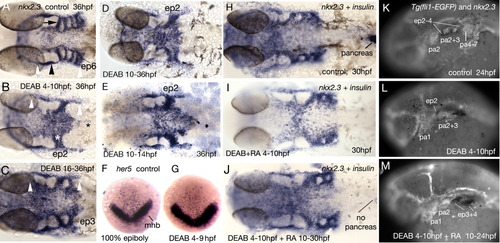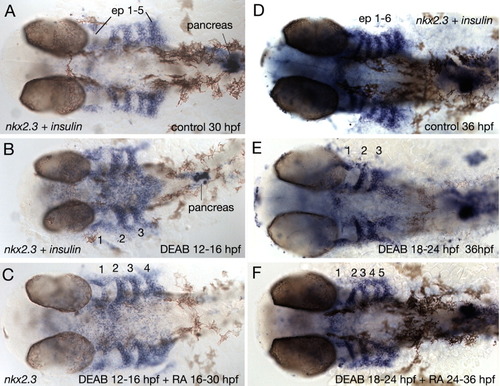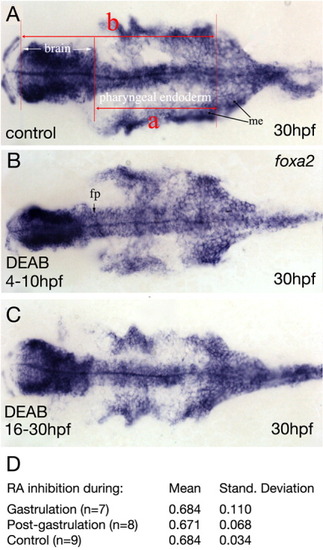- Title
-
Retinoic acid is required for endodermal pouch morphogenesis and not for pharyngeal endoderm specification
- Authors
- Kopinke, D., Sasine, J., Swift, J., Stephens, W.Z., and Piotrowski, T.
- Source
- Full text @ Dev. Dyn.
|
Schematic drawing of the pharyngeal region of a 24-hpf zebrafish embryo. The pharyngeal arches are comprised of mesoderm (green), neural crest cells (gray), endodermal pouches (red), medial pharyngeal endoderm (orange), and lateral ectoderm (blue). Grown zebrafish possess 6 endodermal pouches and 7 pharyngeal arches. Ventral view. ep, endodermal pouches; pa, pharyngeal arches. |
|
Developmental defects observed in live embryos at 30 hpf when RA signaling is impaired. A: Untreated 30-hpf embryo. B: Embryos that were exposed to DEAB during gastrulation from sphere stage (4 hpf) to tailbud stage (10 hpf) show a reduction of the distance between otic vesicle (arrow) and first somite (asterisk) and a kink dorsal to the otic vesicle (arrowhead). Furthermore, the otic vesicle is smaller and only one otholith has formed. C: Embryos treated with DEAB post-gastrulation between 16-30 hpf show aberrant otic vesicle development and heart defects at 30 hpf. ov, otic vesicle; som, somites. Lateral views, anterior to the left. |
|
DEAB treatment during gastrulation causes loss of the posterior neural crest streams and cartilages, whereas treatment post-gastrulation causes fusion of neural crest populations. A,B: Lateral views of confocal projections of GFP-positive cranial neural crest cells in Tg(foxd3:gfp) embryos. Anterior to the left. A: In 30-hpf control embryo, neural crest cells are present in pharyngeal arches 1-5. B: In embryos treated between 4-10 hpf, neural crest cells only populate the first two arches. C,D: Lateral views of 30-hpf embryos labeled with dlx2. C: dlx2 is expressed in neural crest cells in pharyngeal arches 1-5, the diencephalon, and the hypothalamus. D: Expression of dlx2 is lost in the posterior pharyngeal arches 3-5 of embryos treated during gastrulation. E: Ventral view of hand2 expression in the ventral part of pharyngeal arches 1-4 and in the developing heart tube in 30-hpf wild type embryos. F: In embryos treated during gastrulation, only the first two pharyngeal arches are labeled and heart tube morphogenesis does not occur. G,H: In embryos treated with DEAB during gastrulation, the cartilages of the mandibular and hyoid arches are present but smaller in size and misshapen. Cartilages of the posterior arches (3-7) are absent. Ventral views. I: In 30-hpf Tg(foxd3:gfp) embryos treated with DEAB between 16-30 hpf, neural crest cell have migrated into all pharyngeal arches but neural crest populations of the 4th and 5th pharyngeal arches are fused. J,K: In embryos treated post-gastrulation, dlx2 and hand2 are expressed in pharyngeal arches 1-4. L: Even though neural crest cells are present in the posterior pharyngeal arches of embryos treated with DEAB post-gastrulation, they do not differentiate into cartilage. bb, basibranchial; cb, ceratobranchial; ch, ceratohyal; dc, diencephalon; e, ethmoid plate of neurocranium; h, heart tube; hm, hyomandibula; ht, hypothalamus; m, meckel's cartilage; pa1-5, pharyngeal arches 1-5; pq, palatoquadrate. EXPRESSION / LABELING:
|
|
RA only affects hindbrain specification during gastrulation, likely causing postotic neural crest defects. A: Three streams of neural crest cells are labeled with dlx2 at 18 hpf in untreated embryos as seen from a ventral view. B: Embryos in which RA is blocked during gastrulation show a severe reduction of the postotic neural crest stream. A few postotic neural crest cells (s3) migrate anteriorly and ventrally to the ear and fuse with the second neural crest stream (s2, arrowhead). C: Dorsal view of TUNEL stained 14-som control embryo. Anterior to the left. D: Dorsal view of TUNEL-stained embryo that was treated with DEAB between 4-10 hpf. Dying neural crest cells are present in the second neural crest stream (s2, arrow). E: Expression pattern of krox20 in r3 and r5 and in neural crest cells of pharyngeal arches 2-5 at 24 hpf in untreated embryos. Lateral view. F: No expression was seen in r5 in embryos treated with DEAB during gastrulation. G: In 30-hpf untreated embryos, hoxa2 is expressed in r2-r5 and in neural crest cells of the second and more posterior pharyngeal arches. Ventral view. H: Treatment with DEAB during gastrulation causes an expansion of the posterior hindbrain expression domain of hoxa2 and the posterior boundary is more diffuse. Expression in neural crest cells of pharyngeal arches 3-5 is strongly reduced. Inhibition of RA synthesis post gastrulation (16-30 hpf) does not affect hindbrain patterning or neural crest cell migration. I: In embryos treated with DEAB between 16-18 hpf dlx2 staining reveals that neural crest cells migrate normally in three streams. J: Lateral view of 24-hpf TUNEL-stained embryo that was treated with DEAB between 18-24 hpf. No increase is cell death is observed. Anterior to the left. K: Hindbrain segmentation is not affected if embryos are treated with DEAB post-gastrulation. krox20 (K) and hoxa2 (L) expression in the hindbrain is normal. hoxa2 expression in the posterior pharyngeal arch domain is possibly slightly increased. pa, pharyngeal arch; r, rhombomeres; s1-3, neural crest cell streams 1-3. EXPRESSION / LABELING:
|
|
RA is required during morphogenesis of the posterior endodermal pouches. Anterior endodermal pouches develop earlier than more posterior ones and inhibition of RA at different time points only affects newly forming pouches. A-D: ZN8 immunostaining of endodermal pouches, schematic drawing of pouches in 30-hpf control embryos, as well as cartilage staining of 96-hpf embryos. A: 30-hpf control embryos possess five endodermal pouches. At 96 hpf, 7 pharyngeal cartilages have formed. B: Embryos treated with DEAB between 16-30 hpf possess three pouches, pouches 4-5 are absent. At 96 hpf, 3 pharyngeal cartilages have formed. C: Embryos that were treated with DEAB between 20-30 hpf possess three fully formed pouches, the fourth one is only half formed and pouch 5 is missing. At 96 hpf, four pharyngeal cartilages have formed. D: Embryos that were treated between 24-30 hpf have four endodermal pouches and the fifth one is missing. At 96 hpf, five pharyngeal cartilages have formed. Abbreviations are the same as in Figure 3. EXPRESSION / LABELING:
|
|
Loss of RA does not affect pouch endoderm specification. A-E: Ventral views of 36-hpf nkx2.3-labeled control and DEAB-treated embryos. A: In control embryos, nkx2.3 is expressed in pharyngeal pouches 2-5 (arrow) and in the pharyngeal arch ectoderm (black arrowhead). B: In embryos treated with DEAB between 4-10 hpf, the length of the ectodermal domain is normal (white arrowheads) but endodermal pouches 3-6 are missing. The second endodermal pouch is enlarged (white asterisk). Also, nkx2.3 expressing medial cells extend to the posterior edge of the pharyngeal endoderm, indicating that the pharynx as a whole is not shortened (black asterisk). C: In embryos treated with DEAB between 16-36 hpf, the third pouch has formed but pouches 4-5 are absent. D: Treatment with DEAB between 10-36 hpf leads to a similar phenotype as in B. Only an enlarged second pouch is present. E: Shorter treatment with DEAB between 10-14 hpf only causes a slightly less severe phenotype than in D, which demonstrates that DEAB does not get washed out efficiently. F: At 100% epiboly, her5 is expressed in a cell population anterior to the midbrain-hindbrain boundary (mhb), which very likely contains endodermal pouch precursors. No difference in cell number was detected between control (F) and treated embryos (G). H: 30-hpf control embryo hybridized with nkx2.3 and insulin to visualize the pancreas. I: Simultaneous treatment with DEAB and 10-7 M RA between 4-10 hpf leads to almost normal endodermal pouch development by 30 hpf. J: Likewise, treatment of embryos with DEAB between 4-10 hpf, followed by immersion in 10-7 M RA rescues endodermal pouch development normally observed in embryos that are only treated with DEAB. However, RA treatment between 10-30 hpf is unable to restore the formation of the pancreas. This demonstrates that treatment with DEAB during gastrulation does not affect endodermal pouch specification. K-M: Loss of RA signaling between 4-10 hpf causes the loss of the postotic neural crest cells, which are not rescued by subsequent administration of RA. To visualize neural crest cells, treatments were performed in Tg(fli1-EGFP) embryos. fli1 also labels endothelial cells. Embryos were double labeled with nkx2.3 to visualize endodermal pouches. K: 24-hpf control embryo. Neural crest cells are present in pharyngeal arches 1-5 (pa1-pa5). Pharyngeal arches 5-7 have not formed at 24 hpf and the majority of the postotic neural crest cells are present as one population. L: 24-hpf embryo treated with DEAB between 4-10 hpf only possesses neural crest cells in pharyngeal arches 1 and 2 (pa1 and pa2) (L). Subsequent immersion of DEAB-treated embryos in 10-7 M RA rescues the formation of endodermal pouches (ep), as revealed by nkx2.3 but does not rescue the posterior neural crest stream (M). mhb, midbrain-hindbrain boundary; pa, pharyngeal arch; ep, endodermal pouch. |
|
Loss of RA during a 4-hr period post-gastrulation leads to one missing endodermal pouch. A,D: Ventral views of nkx2.3 and insulin expression in the endodermal pouches of 30- and 36-hpf control embryos. B,E: Embryos treated with DEAB between 12-16 hpf (B) and between 18-24 hpf (E). C,F: Embryos treated with DEAB between 12-16 hpf (C) and between 18-24 hpf (F) and subsequent application of 10-7 M RA until 30 hpf (C) and 36 hpf (F). |
|
The medial pharyngeal endoderm is not affected by retinoic acid. A: Ventral view of foxa2 in situ hybridization of 30-hpf control embryo. (B) Embryo treated with DEAB between 4-10 hpf and (C) embryo treated with DEAB between 16-30 hpf. We did not find any significant difference in the length of the expression domain in control versa treated embryos, based on the ratios between the length of the pharyngeal endoderm (distance "a") and the length of the brain (diencephalon) plus the pharyngeal endoderm (distance "b"). D: Statistical analysis of ratios "a"/"b" in embryos treated with DEAB between 4-10 hpf during gastrulation, treated between 16-30 hpf post-gastrulation and untreated control embryos. EXPRESSION / LABELING:
|

